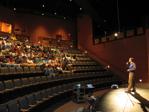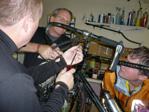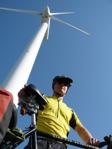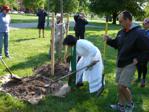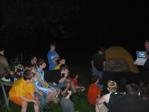Departing Pittsburgh, we pedaled towards Ohio on a drenched Wednesday. At the height of the rain storm, David’s stem (the part that connects the handlebars to the frame) snapped. I have never heard of someone’s stem breaking before (it’s solid metal), but it probably had something to do with the fact that he purchased the stem when he was biking across Argentina. Luckily, we were only 2 miles from a bicycle shop and, with help from our friend Tim , we were on our way.


We arrived in Ohio happy to leave behind the steep rolling hills of western Pennsylvania. Our first stop was Rogers, OH where we met Lloyd Willis and his family. Lloyd works as a parts manager for General Motors and is a dedicated cyclist and bicycle racer. His entire family takes part and they even teach spin classes in their basement. Lloyd talked to us about he often commutes 20 miles each way to work on his ultra light-weight racing bicycle. He said he shows up to work wide awake and arrives home having put in 40 miles of riding and a full day of work. Yet many people look at him as if he’s crazy for riding his bike instead of taking the car. Lloyd gets to do what he loves (bicycle), gets great exercise and saves a bunch of money on gas. Who is crazy?

We stayed with Ed and Barb just outside Youngstown , OH. They treated us to an amazing dinner including some halibut they caught last summer in Alaska. Youngstown, like many towns we passed in this part of the country is shrinking in population even as the US population is growing. This a beautiful part of the US, but the economy of coal, cars, steel and other industry collapsed years ago and the economy still struggles. I wonder how many new jobs could be created with renewable energy. Unfortunately, Ohio doesn’t have a “renewable portfolio standard (RPS)“. RPS is legislation that says a state will produce a certain amount of their energy from renewable sources by a certain date. For example Montana will produce 15% of their energy from renewable sources by 2015. Ohio is one of about 30 states that has not yet passed this legislation. Although it’s no guarantee of new jobs, it does signal to renewable energy companies that the state is serious about promoting renewable energy.


We left Ed and Barb’s house, had a live radio interview (‘Morning with Mangino’) and pedaled on north to the suburbs of Cleveland. There we stayed with Sharon and Ben, who get the prize for most energy efficient household so far (all energy saving light bulbs and a Toyota Prius Hybrid car). The next morning we biked over to the Laurel School to give a presentation to 8th grade girls. What an amazing group of kids! They knew so much about global warming and solutions that they should be riding across the country giving talks.
We left Laurel School in the suburbs and headed toward downtown Cleveland. Our route took us through East Cleveland, parts of which are in serious disrepair. Along the waterfront route we passed a coal burning power plant and a demonstration wind turbine. Which would you prefer in your neighborhood? (Aside from David: More importantly, who looks better – Bill in front of the coal plant, or David in front of the windmill?)
We rode alongside Lake Erie to the west side of Cleveland. Passing along the Cuyuhoga River I couldn’t help but think of our ability to make positive change even when a situation looks bleak. For those who don’t know this, the Cuyuhoga River is famous for catching fire several times in the 1960’s and 1970’s because it was so polluted. News of this helped to wake people up to the seriousness of the problem and began the changes, including the Clean Water Act, that many now take for granted. These changes only happened due to the hard work a few thoughtful and committed citizens.

We rode on 20 miles across Cleveland to Chris and Alys’s house. I went to graduate school with Alys a bunch of years back. Luckily for us, Chris is also renting a condo about 65 miles west in Port Clinton, OH. The next day we left our panniers (bike bags) with Chris to bring to the condo and we biked to Port Clinton. There was a headwind much of the day so, even without the panniers, it feel like we were dragging cinderblocks behind the bikes.
On the way to Port Clinton we found ourselves at the Sundusky Bay Bridge. It’s illegal to bicycle across it because they made no provision for a bike lane and therefore it’s not safe. But there’s no other way to cross by bicycle without going 35 miles out of your way. So we stuck out our thumbs and, within seconds, Don picked us up in his Ford F-150 pick-up truck. Although he works for Ford, he was mad that his F-150 gets 13mpg when his 1969 Camaro has “5 times the horse power” and gets nearly as good mileage. It’s a good question — could we do better?






